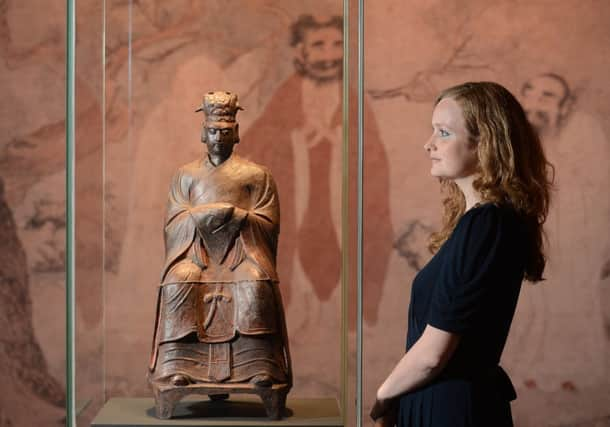Exhibition review: Ming: The Golden Empire, Edinburgh


Ming: The Golden Empire - National Museum of Scotland, Edinburgh
* * *
Classic blue and white Ming-style ceramics came to attain a kind of influence on global style which rivals some of today’s superbrands.
Advertisement
Hide AdThis exhibition aims to give an overview of the period of 1368-1644 when China, under the Ming, was the largest, wealthiest, most populous empire in the world.
The majority of objects in this show have come from the museum in Nanjing, the Ming capital until the dynasty moved north to Beijing and built the Forbidden City in 1420, and many have never left China before. This touring exhibition (for which Edinburgh is the only UK venue) preceeds a Ming show at the British Museum in the autumn, which focuses on a much narrower time period.
This show, then, is Ming China in broad brushstrokes: an all-powerful emperor with a quasi-divine mandate (“Son of Heaven”); a ruling class of men– the “literati” – who passed the rigorous neo-Confucian civil service exams, and formed an educated, cultural elite; economic growth and burgeoning consumerism, including the emergence of an aspirational middle-class.
The tools available to tell this story are objects: porcelain, paintings, ritual artefacts, jewellery, furniture and textiles (though much less of these last two than I might have expected).
The great power objects possess is to narrow the distance between then and now, between there and here, to enable us to understand in a visceral, hairs-on-the-back-of-the-neck-prickling kind of way what it was like to live then and there. Objects have the power to show rather than tell.
But, try as I might, peering into display cases in low light, patiently reading descriptions and provenance, I struggled to get this immediacy here. I know that the Ming built the Forbidden City – and there is a scroll here depicting the architect standing next to his masterpiece – but I didn’t get a sense of what it was like to live there. I didn’t feel any closer to understanding how the Ming emperors governed their vast empire (apart from absolutely), or what it was like to live under them, either as a courtier or a commoner.
Advertisement
Hide AdThe objects here are rare and precious, representing pinnacles of achievement, but we need the small print to tell us how special they are. We need to appreciate the technological demands of what has been achieved – the difficulty of firing a glazed porcelain pot the size of a garden planter, the intricacies of using copper red underglaze.
One of the perverse effects of the worldwide love affair with Ming porcelain, resulting in endless copies both in China and later elsewhere, is that it reduces the impact of seeing the real thing.
Advertisement
Hide AdUnlike the 2002 exhibition at NMS, Forbidden City: Treasures of an Emperor, which drew on the collection of the Palace Museum in Beijing to tell the story of the 18th century Qianlong Emperor, this show lacks the kind of ostentacious treasures which stop the viewer in their tracks. And many of the objects, while great examples of the period, seem to have only tangential relationships to the major players in the story. The story is told in the text panels, which are clear and thorough, but they have to tell because they cannot always show.
Of course, there is plenty here worth seeing. An exquisite piece of jewellery with a gold cicada poised on a jade leaf, pictured below, is a particular highlight.
There are embroideries from the Gu tradition, and astonishing works of cloisonné. There are anecdotes which begin to flesh out this world: an early Ming emperor, keen on spreading the message of China’s sophistication, used ships far larger than any in Europe to send his captains as far as India and East Africa, returning, at one point, with a giraffe.
Art collecting became so popular in the late Ming period that manuals were produced to help new collectors find their way through a proliferation of fakes. And the paintings, largely the vertical monochrome landscapes favoured at the time, repay time spent.
Gradually, the characteristics of individual artists begin to emerge: the free brushstrokes of Yuan Shangtong, for example, as he paints the waves on a stormy sea, and his flock of jackdaws, each bird with its own personality.
Visitors to this exhibition – if they don’t mind working a little – will find plenty to learn and appreciate. But what is less clear is how this burgeoning, sophisticated society compares to Europe at the time, and how people there really lived. We catch brief glimpses, in this exhibition, of its splendour and strangeness, but we never get under its skin.
• Until 19 October